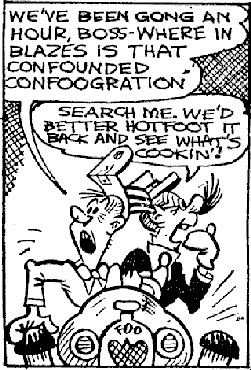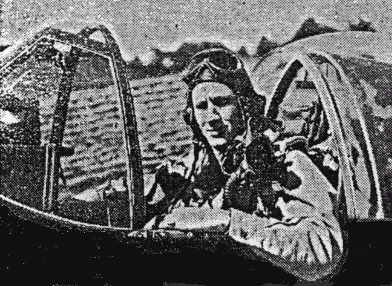IT WASN'T until 1947, when the stories about flying saucers hit page one, that Nashville's Joe Thompson Jr. gave much thought to those strange objects he saw in World War II.
Now an insurance man, Thompson was a photo reconnaissance pilot in the war.
He and his wing man were on a mission over the Rhine Valley, photographing German troop movements, when he saw them.
"We had made some pictures, and I was looking ahead to our next photo target," Thompson recalls, "when my wing man broke radio silence and said, 'Bogeys at 9 o'clock!'"
(A bogey, in air force parlance, is an unidentified flying object — UFO — which could turn out to be either friendly or hostile.)
"Off my wing. a little below us, in the direction of Cologne, I saw four or five objects that looked like silvery footballs," he says.
"They didn't seem to be moving. but they must have been, for they stayed even with us
"It flashed through my mind that they were something the Germans had put up there.
"I watched to see what they would do, but they didn't do anything.
"As we turned away, I thought they must not be of much value to the Germans.
"That's the last I saw of them. I turned my attention to the next photo target, where the Germans were already sending up flak to let us know they were waiting for us."
It wasn't until later that Thompson learned that captured intelligence reports said the Germans had seen the objects, too -- and thought they were put up there by the Americans!
Thompson wasn't the first U.S. pilot to see the strange objects over the Rhine Valley.
They were first spotted by the pilots of Black Widow night fighters, who said they glowed in the dark. The night fighters shot at them a few times, but the fire was never returned.
 He believes the night fighters gave the UFOs the nickname that stuck: "Foo-Fighters," a term picked up from the Smokey Stover comic strip that still runs in several newspapers.
He believes the night fighters gave the UFOs the nickname that stuck: "Foo-Fighters," a term picked up from the Smokey Stover comic strip that still runs in several newspapers.
At the time, Thompson was a major in the 109th Tactical Reconnaissance Squadron. He commanded approximately 45 pilots who flew P-51 Mustangs equipped with powerful aerial cameras and four 50-caliber machine guns.
Most of the sightings of Foo-Fighters took place between December, 1944, and March, 1945.
"When the weather was too bad for flying, I'd go around and talk with the pilots, asking them about the things they had seen on their missions," Thompson recalls.
Ever so often, some one would say he had seen "some of those Foo-Fighters."
What did they look like?
A Californian, Capt Frank Robinson, said they resembled "a smashed beer can." Others said a tennis ball or a football -- only much larger. The descriptions were of shape, not size. Captain Robinson – who said he saw them rising up as from the ground -- called them "Kraut balls." Everybody thought they were German.
There was speculation about their purpose.
"At first, we thought they might be attached to wires, like barrage balloons, Thompson says. "But they were moving, and they were too high."
"Then we got the idea that the Germans might be using them to detect the altitude of our planes so they could place their anti-aircraft fire more accurately."
Then Thompson saw them for himself that day over the Rhine Valley.
"They didn't look like what Captain Robinson had said — a smashed beer can," he remembers.
How big were they?
"I really couldn't tell," he says. "It would put depend on how far away they were. They may have been as close as 1500 feet, in which event they would be no bigger than an open umbrella. But they could have been two miles away in which case they would be quite large. They looked as though they were made of aluminum."
What were they?
"I don't really know," he says. "I saw something — I still don't know what it was."
He reported the sighting to the squadron intelligence officer when he returned from the mission, and let it drop.
The men of the 109th never tried to pursue the objects, Thompson says, because they were not bothering us.".
Today, it is difficult to understand why wartime pilots were not more excited about these Foo-Fighters so many of them saw over Germany. In retrospect, they seem prophetic of the "flying saucer" reports that began to come in profusion after the war.
The wartime lack of excitement is easier to understand in light of the conditions under which Thompson and his fellow pilots flew.
The Foo-Fighters just didn't seem important, he explains. What was important was to complete the mission and stay alive, with so many people on the ground and in the air dedicated to your destruction.
For example, Thompson came back from a mission with 150 holes in his plane — flak. There was even a hole in his camera. Just as he touched ground, the engine quit.
There were several other such examples in the squadron, which lost more planes to
flak than to enemy planes — and more planes to weather than to flak and enemy planes combined.
The squadron flew first from England and then, after the invasion, from an air strip in Normandy and, still later, in Belgium. It was from the tiny Belgian village of Gosselies that they went on missions when they saw the Foo-Fighters.
(Two years ago, Thompson took his wife, Martha, to Gosselies for a sentimental visit. He saw several people he had known there during the war.)
"From Gosselies it was a 20 or 30-minute flight to the Rhine Valley," he says. "We would cruise around for a couple of hours. We were looking for patterns of troop movement, trucks, tanks on the move -- anything that might be of use to intelligence. Our bombers might knock out a bridge. They would send us in to see how much damage was done."
The first missions went out with the first light, hoping to catch the enemy still on the move from the night before. The last missions were out at dusk. Perhaps an over-eager enemy would start the next night's journey early.
The pilots flew in twos, changing altitude all the time, trying to make a difficult target for enemy guns. Survival meant spotting an enemy plane before he spotted you. Their eyes made Ms [sic] scanning the skies for anything that wasn't friendly. They learned to know instantly if a dot on the horizon was friend or foe.
Across the Rhine, Thompson sometimes saw a sobering sight.
If you were in the right place at the right time, you could see what looked like a telephone pole taking off into the sky," he says. "You could follow the trail until it disappeared up and out of sight. This was the V-2 rocket.
"I spent a five-day leave in London and saw these rockets landing in Hyde Park. They made holes three stories deep."
After the war, when flying saucers became the rage, Thompson developed into something of a buff on the subject, reading everything he could find. Sometimes he spoke at civic clubs.
Afterwards people would come up and wonder excitedly if the Foo-Fighters could have been sent from somewhere in space to observe the war in Europe, and, possibly, to gauge the threat of V-2 weapons to their own world.
"The whole problem is to separate fact from fiction," he says of UFOs. "How much of it is imagination? How much is hallucination?" Most of these sightings can be explained. Some can't. A lot of authors could explain some of the incidents they write about, but if they did, their books wouldn't sell as well.
"It is encouraging that scientists are beginning to study the phenomenon. I think the time has come when they can study flying saucers without being suspected of lunacy.
"There are three general groups of people who are concerned with UFOs.
"The first group are those whom we might describe as the insecure, the neurotics. Certainly the things they see are colored by their own troubles and exaggerated speculations.
"The second group are the skeptics who recognize that something must have caused such a multitude of sightings, but they demand unequivocal evidence.
"And then there is a third and growing group of people who, while they do not present any final answer, are willing to state they have seen these objects and have carefully examined the plausible record of other confirmed sightings and feel there must be some sensible explanation.
"The federal government just granted $300,000 to the University of Colorado to investigate, along with some other universities, the sources of unexplained phenomena. I would hope that this amount of money is not being spent just to quiet the fears of the neurotic fringe.
"I think we will have the answer to UFOs within 10 years.
"We have been flying on this planet only 63 years," Thompson says, "and we are now planning to send an astronaut to the moon. This is a long way to go in 63 years, but we still don't know all the answers."

